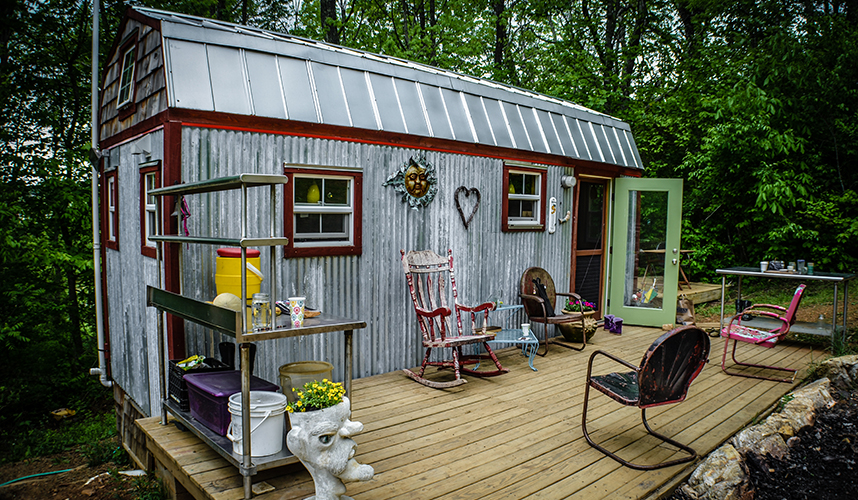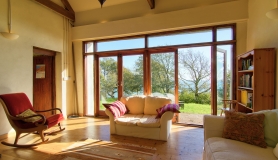The culture of consumption has grown out of control. In the quest for more; more money, status, accomplishment, we risk losing what matters most: our connection to each other and the earth.
We went bankrupt, we lost our business and our house and some friends. It hurts. Real. Bad. But pain shows us where to grow. We grew out of what we thought we needed and into something that was coming for years. We were already moving toward this life even before New Day Cafe. NDC was our attempt to create a community we longed for – one based on art, music, food and companionship. We worked our butts off only to realize it was at the cost of our own sanity. We pushed ourselves to our very edge and almost lost the most important asset we have: each other. Losing everything else was a drastic clearing of the excess. We were left staring each other in the face: What now?
STARTING AFRESH
Our plan was a simple one and simply radical. We would work hard, stop buying, sell, donate, downsize, make a budget, and save every penny. We would find a little piece of land, buy it for cash, and grow a homestead.
We now live in a tiny house, on three acres of land in Floyd, Virginia, raising chickens, pigs, and growing vegetables, whilst our kids grow into early adolescence. Mothering in a tiny house is rich with opportunities to grow. Because we are crammed into such a small physical space, we have a microscope on our relationships. Patience and peace, please! Sometimes, there is no room for those. The practice is making room.
Our tiny house took 10 months to build. And the foundation is an 8 x 21 flatbed trailer, so the footprint is 168 sq. ft. Add to that two separate sleeping lofts. It was challenging to adapt to living in a smaller home. At first we had to adapt physically. We bumped our bodies a lot - tossing at night and I bumped my head on the ceiling in the loft and on the sink in the bathroom. We bumped into each other.
And psychologically, we spent a couple of years preparing to move into the tiny house, so the downsizing process was quite long. We held yard sales and donated lots of our things. Then there’s the emotional adapting which is ongoing for us. With four of us in this tiny space, our emotions can fill it up quickly. We’ve learned some techniques, but we’ll never be done learning how to communicate. It’s important for us to express when we need space, help, when we’re sad, angry, etc. If we don’t clearly communicate our feelings, they can overwhelm us in this tiny space.
MISSING LITTLE LUXURIES
I have always missed a bathtub. If I built the tiny house again, I would include a tub. When we consult with others, I make sure to share my feelings about including a bathtub in the design. I also miss our couch. We had a big comfy couch on which we could all lounge comfortably together. We sold it before we moved. It would take up our entire living space in the tiny house.
When the weather is nice, it doesn’t even feel like we live tiny - the living is easy. It is hard in the dead of winter, though. Now that the kids are getting bigger, we’re more crowded, and the kids’ need for privacy is becoming more clear. They are loud which is difficult when I’m trying to write or focus in any way. They bring stuff home everyday - and they don’t always keep it where it goes, so we have to stay on top of it constantly. Then there is the privacy as a couple issue. We do have to be creative about finding time as a couple. But we have separate lofts and then the kids aren’t always home so we manage.
“At first we had to adapt physically. We bumped our bodies a lot - tossing at night and i bumped my head on the ceiling in the loft and on the sink in the bathroom. We bumped into each other”
MONEY SAVING
Because we live without a mortgage, we save at least $1000 per month just by living here. It takes very little to heat the tiny house, so the electricity bill is about a quarter of what it was in our last house. We have well-water and septic, so we don’t have any utility costs except electric.
The biggest inconvenience of living in a tiny house is not having a space for our creative work. We each need and want a little room of our own to write, paint, make music, sew, etc. And the biggest joy is that we’ve made it work. This tiny space seemed impossible to turn into a home, but this really is home and has been for three and a half years. It’s taught us so much about what we value. Oh yeah, and we’re mortgage-free!
Tiny houses are a great way for folks to live in dignity and to gain freedom from the system that keeps us trapped in debt and consumption. I think more and more people are rethinking what home means, designing a home to meet personal needs, and not trying to fit into a home that was mass-produced. I think we need to be careful when talking about tiny, though. It’s not so much about how many square feet we have, and having the tiniest house, but how we use and live in the space. It’s about right-sizing our homes, and living comfortably within our means. For us, the experience of living tiny has informed our lifestyle, and we are forever shaped by it. Living tiny means we live fully in our space and use it to its fullest capacity.
SAVING SPACE
We designed our tiny house after closely studying the traffic patterns in our daily lives. We accommodated every activity in our former house the best we could.
- Our tiny house has a foyer with a shoe bench. We keep all of our shoes inside the bench. It’s storage and also a place to sit and take-off or put-on shoes.
- We use shallow shelving for our stuff. This helps us to see what we have and not lose track of hidden items in the back of a cupboard or deeper shelf.
- We each have a cabinet for our clothing, and a junk-drawer for our papers and other treasures.
- The couch lifts up for storage underneath.
- We use lots of hooks which are quite helpful for a quick place to get something like a backpack or coat off the floor.
- We hang our dining chairs on the wall and the table folds up and leans against the wall.
MORE INSPIRATION
READ Coming Home Letters from a Tiny Home by Hari Kaur Berzins, available from tinyhousefamily.com







